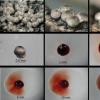
20-12-2025 23:08
Patrice TANCHAUDBonsoir, récolte sur sol sablonneux dans l'arri�

21-12-2025 09:32
Hello.A tiny ascomycete found embedded in wood in

20-12-2025 15:47
Mirek GrycHi.These grew on pine wood that was heavily covere

18-12-2025 21:17
Pol DebaenstThe identification took me to Byssonectria deformi

15-12-2025 07:09
 Danny Newman
Danny Newman
indet. Rutstroemiaceae sp. on unk. fallen leavesMc

19-12-2025 10:10
Patrice TANCHAUDBonjour, récolte réalisée en milieu dunaire, a

18-12-2025 17:23
 Bruno Coué
Bruno Coué
Bonjour,je serais heureux d'avoir votre avis sur c
Bloody Hypoxylon!?
Dartanha Soares,
11-04-2016 23:18
 Hi to all,
Hi to all,Found this one on decorticated wood (unknown), but I did not have much time to work on it.
Ascospores are 12.5-14.5x5.6-6.5 micra, with sigmoid germ slit (full spore length), perispore dehiscent.
What called my attention was the "red-blood" pigment on KOH 10%.
Any hint will be welcome.
Jacques Fournier,
12-04-2016 08:39

Re : Bloody Hypoxylon!?
Hi Dartanha,
this is strongly suggesting H. lenormandii but the red pigments in KOH are indeed deviaiting from those encountered in typical H. lenormandii. It is worth a more detailed study.
Cheers,
Jacques
this is strongly suggesting H. lenormandii but the red pigments in KOH are indeed deviaiting from those encountered in typical H. lenormandii. It is worth a more detailed study.
Cheers,
Jacques
Dartanha Soares,
12-04-2016 13:44

Re : Bloody Hypoxylon!?
Hi Jacques,
Thank you very much.
I looked at Kuhnert et al. paper (Fungal Diversity (2015) 71:165–184) and it fits well. They mentioned that this fungus "have Blood colour (3) and Dark Vinaceous (84) pigments in KOH", and is already reported from Brazil (a single specimen collected by Rick in 1906!!).
But as you said, it deserves further studies, since according to them "H. lenormandii" seems to be a species-complex.
Once again, thank you very much!!
Thank you very much.
I looked at Kuhnert et al. paper (Fungal Diversity (2015) 71:165–184) and it fits well. They mentioned that this fungus "have Blood colour (3) and Dark Vinaceous (84) pigments in KOH", and is already reported from Brazil (a single specimen collected by Rick in 1906!!).
But as you said, it deserves further studies, since according to them "H. lenormandii" seems to be a species-complex.
Once again, thank you very much!!

